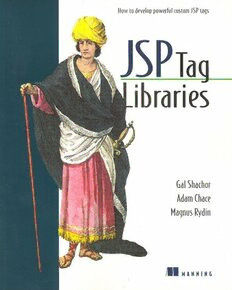
JSP Tag Libraries PDF
652 Pages·2001·10.678 MB·English
Most books are stored in the elastic cloud where traffic is expensive. For this reason, we have a limit on daily download.
Preview JSP Tag Libraries
Description:
This is a review I did for AustonJUG group. Since it is a long review (more than 1000 words), I only post the overview here....Working with other server side Java components, such as JavaBeans, EJBs and JDBC, properly designed custom tag libraries allow developers to encapsulate and reuse code. Custom tags create a tag-based content authoring environment and allow web authors to write highly dynamic web applications in HTML style without learning the Java programming language. So, architects, developers and content authors can all benefit from studying JSP custom tags.Manning's book "JSP Tag Libraries" by Gal Shachor, Adam Chace and Magnus Rydin (ISBN 1-930110-09-X) is an excellent JSP custom tag text suited for both new and seasoned developers. This book covers JSP specifications 1.1 and 1.2.One of the main strengths of this book is that it does not merely repeat API documentations. The authors put a lot of effort to show the readers the big picture, the philosophy behind JSP custom tags and how to apply them in real world applications. This book talks about "why" as well as "how".After studying this book, the reader should be able to understand:* What JSP custom tags are and why we need them; * How custom tags work; * How to use tags to perform common and advanced tasks; * Steps to develop and deploy tag applications; * Basic design patterns for tag applications;The book is very well organized and well written. It is full of excellent code examples. Those examples put the techniques into context. The readers can learn effectively by playing with the examples. As added bonuses, the code examples can be easily adopted for real world applications. In section "Case Studies", the authors discuss two complete multi-tier E-commerce and M-commerce applications. They offer not only code examples on applying practical techniques but also insights and templates on how to design good JSP applications.All the code examples in the book are annotated with in-depth explaining text. That truly helps readers to understand not only what the code is doing but also what the authors intended to do.However, there are still things I wish the authors could improve in the next version:1. The authors had excellent discussions on how to implement conditional tags, iteration tags and database access tags. But they did not mention similar tag libraries under development by the Jakarta Taglib project. I would really like to hear about their insights on the designs of Jakarta tag libraries and many similar libraries developed by commercial companies.2. In the "Case Studies" part, it is quite easy to add a parallel WAP store front to the JDBC-driven WebStore through another set of custom tags. That would really drive home the power of separating business logic from presentation logic and highlight the flexibility of a JSP custom tag based solution. I wish the authors had done that.Overall, I think this is an excellent book and would like to HIGHLY RECOMMEND it to anyone working with JavaServer Pages technology.
See more
The list of books you might like
Most books are stored in the elastic cloud where traffic is expensive. For this reason, we have a limit on daily download.
